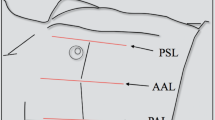Abstract
Purpose
Combined clinical examination and supine chest radiography have shown low accuracy in the assessment of pneumothorax in unstable patients with major chest trauma during the primary survey in the emergency room. The aim of our study was to evaluate the diagnostic accuracy of extended-focused assessment with sonography in trauma (e-FAST), in the diagnosis of pneumothorax, compared with the results of multidetector computed tomography (MDCT) and of invasive interventions (thoracostomy tube placement).
Materials and methods
This was a retrospective case series involving 368 consecutive unstable adult patients (273 men and 95 women; average age, 25 years; range, 16–68 years) admitted to our hospital’s emergency department between January 2011 and December 2012 for major trauma (Injury Severity Score ≥ 15). We evaluated the accuracy of thoracic ultrasound in the detection of pneumothorax compared with the results of MDCT and invasive interventions (thoracostomy tube placement). Institutional review board approval was obtained prior to commencement of this study.
Results
Among the 736 lung fields included in the study, 87 pneumothoraces were detected with thoracic CT scans (23.6 %). e-FAST detected 67/87 and missed 20 pneumothoraces (17 mild, 3 moderate). The diagnostic performance of ultrasound was: sensitivity 77 % (74 % in 2011 and 80 % in 2012), specificity 99.8 %, positive predictive value 98.5 %, negative predictive value 97 %, accuracy 97.2 % (67 true positive; 668 true negative; 1 false positive; 20 false negative); 17 missed mild pneumothoraces were not immediately life-threatening (thickness less than 5 mm).
Conclusions
Thoracic ultrasound (e-FAST) is a rapid and accurate first-line, bedside diagnostic modality for the diagnosis of pneumothorax in unstable patients with major chest trauma during the primary survey in the emergency room.




Similar content being viewed by others
References
Noppen M, De Keukeleire T (2008) Pneumothorax. Respiration 76:121–127
Kirkpatrick AW, Sirois M, Laupland KB et al (2004) Hand-held thoracic sonography for detecting post-traumatic pneumothoraces: the Extended Focused Assessment with Sonography for Trauma (EFAST). J Trauma 57:288–295
Soldati G, Testa A, Sher S et al (2008) Occult traumatic pneumothorax: diagnostic accuracy of lung ultrasonography in the emergency department. Chest 133:204–211
Scalea TM, Rodriguez A, Chiu W et al (1999) Focused Assessment with Sonography for trauma (FAST): results from an international consensus conference. J Trauma 46:466–472
Korner M, Krotz MM, Degenhart C et al (2008) Current role of emergency US in patients with major trauma. Radiographics 28:225–242
Wilkerson GR, Stone MB (2010) Sensitivity of bedside ultrasound and supine anteroposterior chest radiographs for the identification of Pneumothorax after blunt trauma. Acad Emerg Med 17:11–17
Ding W, Shen Y, Yang J et al (2011) Diagnosis of pneumothorax by radiograph and ultrasonography: a meta-analysis. Chest 140:859–866
Volpicelli G (2011) Sonographic diagnosis of pneumothorax. Intensive Care Med 37:224–232
Tocino IM, Miller MH, Fairfax WR (1985) Distribution of pneumothorax in the supine and semi-recumbent critically ill adult. AJR Am J Roentgenol 144:901–905
Lichtenstein DA, Menu Y (1995) A bedside ultrasound sign ruling-out pneumothorax in the critically ill. Lung sliding. Chest 108:1345–1348
Lichtenstein DA, Meziere G, Biderman P (1997) The comet tail artifact. An ultrasound sign of alveolar-interstitial syndrome. Am J Respir Crit Care Med 156:1640–1646
Garofalo G, Busso M, Perotto F et al (2006) Ultrasound diagnosis of pneumothorax. Radiol Med 111:516–525
Lichtenstein DA, Meziere G, Biderman P, Gepner A (2000) The lung point: an ultrasound sign specific to pneumothorax. Intensive Care Med 26:1434–1440
Lichtenstein DA (2007) Ultrasound in the management of thoracic disease. Crit Care Med 35(5 Suppl):S250–S261
Volpicelli G, Elbarbary M, Blaivas M et al: International Liaison Committee on Lung Ultrasound (ILC-LUS) (2012) International evidence-based recommendations for point-of-care lung ultrasound. Intensive Care Med 38:577–591
American College of Surgeons Committee on Trauma (1997) Advanced Trauma Life Support (ATLS®) for Physicians, 7th edn. American College of Surgeons, Chicago
Conflict of interest
Stefania Ianniello, Vincenza Di Giacomo, Barbara Sessa, Vittorio Miele declare no conflict of interest.
Author information
Authors and Affiliations
Corresponding author
Rights and permissions
About this article
Cite this article
Ianniello, S., Di Giacomo, V., Sessa, B. et al. First-line sonographic diagnosis of pneumothorax in major trauma: accuracy of e-FAST and comparison with multidetector computed tomography. Radiol med 119, 674–680 (2014). https://doi.org/10.1007/s11547-014-0384-1
Received:
Accepted:
Published:
Issue Date:
DOI: https://doi.org/10.1007/s11547-014-0384-1




